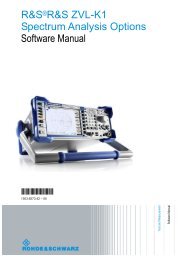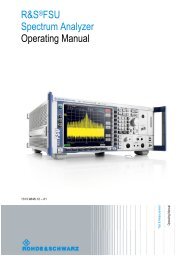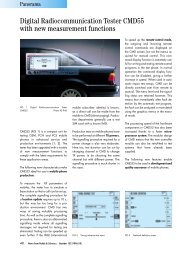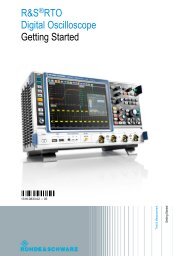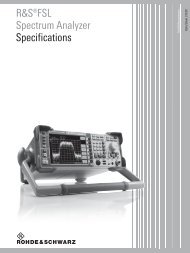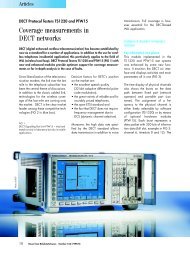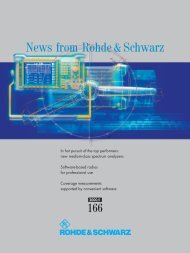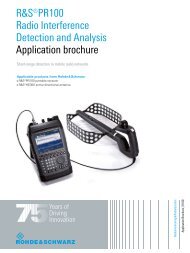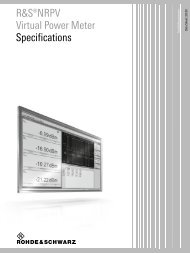- Page 1 and 2:
R&S ® FSQ Signal Analyzer Operatin
- Page 3 and 4:
Basic Safety Instructions Always re
- Page 5 and 6:
Electrical safety Basic Safety Inst
- Page 7 and 8:
Repair and service Basic Safety Ins
- Page 9 and 10:
Informaciones elementales de seguri
- Page 11 and 12:
Seguridad eléctrica Informaciones
- Page 13 and 14:
Informaciones elementales de seguri
- Page 15 and 16:
Customer Information Regarding Prod
- Page 17 and 18:
Customer Support Technical support
- Page 19 and 20:
R&S FSQ Documentation Overview Tabb
- Page 21 and 22:
R&S FSQ Documentation Overview Chap
- Page 23 and 24:
R&S FSQ Putting into Operation 1 Pu
- Page 25 and 26:
R&S FSQ Getting Started 2 Getting S
- Page 27 and 28:
R&S FSQ Getting Started Measuring t
- Page 29 and 30:
R&S FSQ Getting Started Measuring t
- Page 31 and 32:
R&S FSQ Getting Started Measuring t
- Page 33 and 34:
R&S FSQ Getting Started Measuring S
- Page 35 and 36:
R&S FSQ Getting Started Impact of t
- Page 37 and 38:
R&S FSQ Getting Started Measuring S
- Page 39 and 40:
R&S FSQ Getting Started Measuring S
- Page 41 and 42:
R&S FSQ Getting Started 2.4 Noise M
- Page 43 and 44:
R&S FSQ Getting Started Determining
- Page 45 and 46:
R&S FSQ Getting Started Noise Measu
- Page 47 and 48:
R&S FSQ Getting Started Noise Measu
- Page 49 and 50:
R&S FSQ Getting Started 2.4.3 Measu
- Page 51 and 52:
R&S FSQ Getting Started 2.5 Measure
- Page 53 and 54:
R&S FSQ Getting Started Measurement
- Page 55 and 56:
R&S FSQ Getting Started 2.5.2.1 Mea
- Page 57 and 58:
R&S FSQ Getting Started Fig. 2.21 D
- Page 59 and 60:
R&S FSQ Getting Started Measurement
- Page 61 and 62:
R&S FSQ Getting Started Measurement
- Page 63 and 64:
R&S FSQ Getting Started Measurement
- Page 65 and 66:
R&S FSQ Getting Started 6. Switchin
- Page 67 and 68:
R&S FSQ Getting Started Measurement
- Page 69 and 70:
R&S FSQ Getting Started Measurement
- Page 71 and 72:
R&S FSQ Getting Started Measurement
- Page 73 and 74:
R&S FSQ Getting Started Measurement
- Page 75 and 76:
R&S FSQ Getting Started 2.5.4 Ampli
- Page 77 and 78:
R&S FSQ Getting Started Fig. 2.36 T
- Page 79 and 80:
R&S FSQ Manual Operation 3 Manual O
- Page 81 and 82:
R&S FSQ Instrument Functions 4 Inst
- Page 83 and 84:
R&S FSQ Instrument Functions 4.8.4
- Page 85 and 86:
R&S FSQ Instrument Functions R&S FS
- Page 87 and 88:
R&S FSQ Instrument Functions 4.3 Mo
- Page 89 and 90:
R&S FSQ Instrument Functions 4.5 An
- Page 91 and 92:
R&S FSQ Instrument Functions Analyz
- Page 93 and 94:
R&S FSQ Instrument Functions Analyz
- Page 95 and 96:
R&S FSQ Instrument Functions Analyz
- Page 97 and 98:
R&S FSQ Instrument Functions RF ATT
- Page 99 and 100:
R&S FSQ Instrument Functions EL ATT
- Page 101 and 102:
R&S FSQ Instrument Functions BW Ana
- Page 103 and 104:
R&S FSQ Instrument Functions Analyz
- Page 105 and 106:
R&S FSQ Instrument Functions RBW /
- Page 107 and 108:
R&S FSQ Instrument Functions Table
- Page 109 and 110:
R&S FSQ Instrument Functions MAIN P
- Page 111 and 112:
R&S FSQ Instrument Functions SWEEP
- Page 113 and 114:
R&S FSQ Instrument Functions SGL SW
- Page 115 and 116:
R&S FSQ Instrument Functions The de
- Page 117 and 118:
R&S FSQ Instrument Functions GATE M
- Page 119 and 120:
R&S FSQ Instrument Functions DELAY
- Page 121 and 122:
R&S FSQ Instrument Functions SELECT
- Page 123 and 124:
R&S FSQ Instrument Functions Analyz
- Page 125 and 126:
R&S FSQ Instrument Functions ASCII
- Page 127 and 128:
R&S FSQ Instrument Functions Exampl
- Page 129 and 130:
R&S FSQ Instrument Functions DETECT
- Page 131 and 132:
R&S FSQ Instrument Functions DETECT
- Page 133 and 134:
R&S FSQ Instrument Functions CAL CO
- Page 135 and 136:
R&S FSQ Instrument Functions MKR MA
- Page 137 and 138:
R&S FSQ Instrument Functions SIGNAL
- Page 139 and 140:
R&S FSQ Instrument Functions MARKER
- Page 141 and 142:
R&S FSQ Instrument Functions STEPSI
- Page 143 and 144:
R&S FSQ Instrument Functions 4.5.11
- Page 145 and 146:
R&S FSQ Instrument Functions PH NOI
- Page 147 and 148:
R&S FSQ Instrument Functions 4.5.11
- Page 149 and 150:
R&S FSQ Instrument Functions Analyz
- Page 151 and 152:
R&S FSQ Instrument Functions MARKER
- Page 153 and 154:
R&S FSQ Instrument Functions SELECT
- Page 155 and 156:
R&S FSQ Instrument Functions THRESH
- Page 157 and 158:
R&S FSQ Instrument Functions Analyz
- Page 159 and 160:
R&S FSQ Instrument Functions MEAS A
- Page 161 and 162:
R&S FSQ Instrument Functions POWER
- Page 163 and 164:
R&S FSQ Instrument Functions The de
- Page 165 and 166:
R&S FSQ Instrument Functions 4.5.13
- Page 167 and 168:
R&S FSQ Instrument Functions Fig. 4
- Page 169 and 170:
R&S FSQ Instrument Functions CP/ACP
- Page 171 and 172:
R&S FSQ Instrument Functions CP/ACP
- Page 173 and 174:
R&S FSQ Instrument Functions Resolu
- Page 175 and 176:
R&S FSQ Instrument Functions CP/ACP
- Page 177 and 178:
R&S FSQ Instrument Functions CHANNE
- Page 179 and 180:
R&S FSQ Instrument Functions CP/ACP
- Page 181 and 182:
R&S FSQ Instrument Functions ACP LI
- Page 183 and 184:
R&S FSQ Instrument Functions ADJ RE
- Page 185 and 186:
R&S FSQ Instrument Functions Analyz
- Page 187 and 188:
R&S FSQ Instrument Functions ADJUST
- Page 189 and 190:
R&S FSQ Instrument Functions video
- Page 191 and 192:
R&S FSQ Instrument Functions SIGNAL
- Page 193 and 194:
R&S FSQ Instrument Functions Analyz
- Page 195 and 196:
R&S FSQ Instrument Functions GATED
- Page 197 and 198:
R&S FSQ Instrument Functions t1 Ext
- Page 199 and 200:
R&S FSQ Instrument Functions MODULA
- Page 201 and 202:
R&S FSQ Instrument Functions Analyz
- Page 203 and 204:
R&S FSQ Instrument Functions Analyz
- Page 205 and 206:
R&S FSQ Instrument Functions HARMON
- Page 207 and 208:
R&S FSQ Instrument Functions SPURIO
- Page 209 and 210:
R&S FSQ Instrument Functions INS BE
- Page 211 and 212:
R&S FSQ Instrument Functions LIST E
- Page 213 and 214:
R&S FSQ Instrument Functions Table
- Page 215 and 216:
R&S FSQ Instrument Functions Provid
- Page 217 and 218:
R&S FSQ Instrument Functions Path a
- Page 219 and 220:
R&S FSQ Instrument Functions Path a
- Page 221 and 222:
R&S FSQ Instrument Functions Analyz
- Page 223 and 224:
R&S FSQ Instrument Functions
- Page 225 and 226:
R&S FSQ Instrument Functions Child
- Page 227 and 228:
R&S FSQ Instrument Functions Analyz
- Page 229 and 230:
R&S FSQ Instrument Functions • Tr
- Page 231 and 232:
R&S FSQ Instrument Functions Analyz
- Page 233 and 234:
R&S FSQ Instrument Functions 4.6 Ba
- Page 235 and 236:
R&S FSQ Instrument Functions SELECT
- Page 237 and 238:
R&S FSQ Instrument Functions DELETE
- Page 239 and 240:
R&S FSQ Instrument Functions NAME T
- Page 241 and 242:
R&S FSQ Instrument Functions Basic
- Page 243 and 244:
R&S FSQ Instrument Functions DISPLA
- Page 245 and 246:
R&S FSQ Instrument Functions Fig. 4
- Page 247 and 248:
R&S FSQ Instrument Functions CONFIG
- Page 249 and 250:
R&S FSQ Instrument Functions Basic
- Page 251 and 252:
R&S FSQ Instrument Functions VIEW T
- Page 253 and 254:
R&S FSQ Instrument Functions REFERE
- Page 255 and 256:
R&S FSQ Instrument Functions YIG FI
- Page 257 and 258:
R&S FSQ Instrument Functions • Ma
- Page 259 and 260:
R&S FSQ Instrument Functions EDIT T
- Page 261 and 262:
R&S FSQ Instrument Functions TRD FA
- Page 263 and 264:
R&S FSQ Instrument Functions GENERA
- Page 265 and 266:
R&S FSQ Instrument Functions Basic
- Page 267 and 268:
R&S FSQ Instrument Functions COM IN
- Page 269 and 270:
R&S FSQ Instrument Functions Basic
- Page 271 and 272:
R&S FSQ Instrument Functions CONFIG
- Page 273 and 274:
R&S FSQ Instrument Functions Basic
- Page 275 and 276:
R&S FSQ Instrument Functions PAGE U
- Page 277 and 278:
R&S FSQ Instrument Functions DISPLA
- Page 279 and 280:
R&S FSQ Instrument Functions SYSTEM
- Page 281 and 282:
R&S FSQ Instrument Functions Genera
- Page 283 and 284:
R&S FSQ Instrument Functions PAGE U
- Page 285 and 286:
R&S FSQ Instrument Functions OPEN S
- Page 287 and 288:
R&S FSQ Instrument Functions SAVE |
- Page 289 and 290:
R&S FSQ Instrument Functions Basic
- Page 291 and 292:
R&S FSQ Instrument Functions Basic
- Page 293 and 294:
R&S FSQ Instrument Functions DELETE
- Page 295 and 296:
R&S FSQ Instrument Functions PRINT
- Page 297 and 298:
R&S FSQ Instrument Functions INSTAL
- Page 299 and 300:
R&S FSQ Instrument Functions SELECT
- Page 301 and 302:
R&S FSQ Instrument Functions NETWOR
- Page 303 and 304:
R&S FSQ Instrument Functions SOURCE
- Page 305 and 306:
R&S FSQ Instrument Functions 4.7.2.
- Page 307 and 308:
R&S FSQ Instrument Functions Tracki
- Page 309 and 310:
R&S FSQ Instrument Functions CAL RE
- Page 311 and 312:
R&S FSQ Instrument Functions FREQUE
- Page 313 and 314:
R&S FSQ Instrument Functions MODULA
- Page 315 and 316:
R&S FSQ Instrument Functions Extern
- Page 317 and 318:
R&S FSQ Instrument Functions SOURCE
- Page 319 and 320:
R&S FSQ Instrument Functions 4.8.2.
- Page 321 and 322:
R&S FSQ Instrument Functions Extern
- Page 323 and 324:
R&S FSQ Instrument Functions CAL RE
- Page 325 and 326:
R&S FSQ Instrument Functions EXT SO
- Page 327 and 328:
R&S FSQ Instrument Functions • TY
- Page 329 and 330:
R&S FSQ Instrument Functions FREQUE
- Page 331 and 332:
R&S FSQ Instrument Functions GEN RE
- Page 333 and 334:
R&S FSQ Instrument Functions LAN In
- Page 335 and 336:
R&S FSQ Instrument Functions 4.10.1
- Page 337 and 338:
R&S FSQ Instrument Functions 4.11.1
- Page 339 and 340:
R&S FSQ Instrument Functions RSIB I
- Page 341 and 342:
R&S FSQ Instrument Functions RSIB I
- Page 343 and 344:
R&S FSQ Instrument Functions Parame
- Page 345 and 346:
R&S FSQ Instrument Functions RSIB I
- Page 347 and 348:
R&S FSQ Instrument Functions TraceB
- Page 349 and 350: R&S FSQ Instrument Functions ' Set
- Page 351 and 352: R&S FSQ Instrument Functions // Act
- Page 353 and 354: R&S FSQ Instrument Functions Digita
- Page 355 and 356: R&S FSQ Instrument Functions 4.12.3
- Page 357 and 358: R&S FSQ Instrument Functions 4.12.5
- Page 359 and 360: R&S FSQ Instrument Functions FREQ L
- Page 361 and 362: R&S FSQ Instrument Functions EXTERN
- Page 363 and 364: R&S FSQ Instrument Functions CONV L
- Page 365 and 366: R&S FSQ Instrument Functions DELETE
- Page 367 and 368: R&S FSQ Instrument Functions ... ..
- Page 369 and 370: R&S FSQ Instrument Functions S/N -
- Page 371 and 372: R&S FSQ Instrument Functions LO/IF
- Page 373 and 374: R&S FSQ Instrument Functions LO/IF
- Page 375 and 376: R&S FSQ Instrument Functions 1 AP C
- Page 377 and 378: R&S FSQ Instrument Functions 1 SA A
- Page 379 and 380: R&S FSQ Instrument Functions 1 AP C
- Page 381 and 382: R&S FSQ Instrument Functions 1 AP C
- Page 383 and 384: R&S FSQ Remote Control - Basics 5 R
- Page 385 and 386: R&S FSQ Remote Control - Basics 5.1
- Page 387 and 388: R&S FSQ Remote Control - Basics Sta
- Page 389 and 390: R&S FSQ Remote Control - Basics 5.4
- Page 391 and 392: R&S FSQ Remote Control - Basics Str
- Page 393 and 394: R&S FSQ Remote Control - Basics Str
- Page 395 and 396: R&S FSQ Remote Control - Basics Str
- Page 397 and 398: R&S FSQ Remote Control - Basics Boo
- Page 399: R&S FSQ Remote Control - Basics 5.6
- Page 403 and 404: R&S FSQ Remote Control - Basics EVE
- Page 405 and 406: R&S FSQ Remote Control - Basics 5.7
- Page 407 and 408: R&S FSQ Remote Control - Basics 5.7
- Page 409 and 410: R&S FSQ Remote Control - Basics 5.7
- Page 411 and 412: R&S FSQ Remote Control - Basics 5.7
- Page 413 and 414: R&S FSQ Remote Control - Basics 5.7
- Page 415 and 416: R&S FSQ Remote Control - Basics Sta
- Page 417 and 418: R&S FSQ Remote Control - Descriptio
- Page 419 and 420: R&S FSQ Remote Control - Descriptio
- Page 421 and 422: R&S FSQ Remote Control - Descriptio
- Page 423 and 424: R&S FSQ Remote Control - Descriptio
- Page 425 and 426: R&S FSQ Remote Control - Descriptio
- Page 427 and 428: R&S FSQ Remote Control - Descriptio
- Page 429 and 430: R&S FSQ Remote Control - Descriptio
- Page 431 and 432: R&S FSQ Remote Control - Descriptio
- Page 433 and 434: R&S FSQ Remote Control - Descriptio
- Page 435 and 436: R&S FSQ Remote Control - Descriptio
- Page 437 and 438: R&S FSQ Remote Control - Descriptio
- Page 439 and 440: R&S FSQ Remote Control - Descriptio
- Page 441 and 442: R&S FSQ Remote Control - Descriptio
- Page 443 and 444: R&S FSQ Remote Control - Descriptio
- Page 445 and 446: R&S FSQ Remote Control - Descriptio
- Page 447 and 448: R&S FSQ Remote Control - Descriptio
- Page 449 and 450: R&S FSQ Remote Control - Descriptio
- Page 451 and 452:
R&S FSQ Remote Control - Descriptio
- Page 453 and 454:
R&S FSQ Remote Control - Descriptio
- Page 455 and 456:
R&S FSQ Remote Control - Descriptio
- Page 457 and 458:
R&S FSQ Remote Control - Descriptio
- Page 459 and 460:
R&S FSQ Remote Control - Descriptio
- Page 461 and 462:
R&S FSQ Remote Control - Descriptio
- Page 463 and 464:
R&S FSQ Remote Control - Descriptio
- Page 465 and 466:
R&S FSQ Remote Control - Descriptio
- Page 467 and 468:
R&S FSQ Remote Control - Descriptio
- Page 469 and 470:
R&S FSQ Remote Control - Descriptio
- Page 471 and 472:
R&S FSQ Remote Control - Descriptio
- Page 473 and 474:
R&S FSQ Remote Control - Descriptio
- Page 475 and 476:
R&S FSQ Remote Control - Descriptio
- Page 477 and 478:
R&S FSQ Remote Control - Descriptio
- Page 479 and 480:
R&S FSQ Remote Control - Descriptio
- Page 481 and 482:
R&S FSQ Remote Control - Descriptio
- Page 483 and 484:
R&S FSQ Remote Control - Descriptio
- Page 485 and 486:
R&S FSQ Remote Control - Descriptio
- Page 487 and 488:
R&S FSQ Remote Control - Descriptio
- Page 489 and 490:
R&S FSQ Remote Control - Descriptio
- Page 491 and 492:
R&S FSQ Remote Control - Descriptio
- Page 493 and 494:
R&S FSQ Remote Control - Descriptio
- Page 495 and 496:
R&S FSQ Remote Control - Descriptio
- Page 497 and 498:
R&S FSQ Remote Control - Descriptio
- Page 499 and 500:
R&S FSQ Remote Control - Descriptio
- Page 501 and 502:
R&S FSQ Remote Control - Descriptio
- Page 503 and 504:
R&S FSQ Remote Control - Descriptio
- Page 505 and 506:
R&S FSQ Remote Control - Descriptio
- Page 507 and 508:
R&S FSQ Remote Control - Descriptio
- Page 509 and 510:
R&S FSQ Remote Control - Descriptio
- Page 511 and 512:
R&S FSQ Remote Control - Descriptio
- Page 513 and 514:
R&S FSQ Remote Control - Descriptio
- Page 515 and 516:
R&S FSQ Remote Control - Descriptio
- Page 517 and 518:
R&S FSQ Remote Control - Descriptio
- Page 519 and 520:
R&S FSQ Remote Control - Descriptio
- Page 521 and 522:
R&S FSQ Remote Control - Descriptio
- Page 523 and 524:
R&S FSQ Remote Control - Descriptio
- Page 525 and 526:
R&S FSQ Remote Control - Descriptio
- Page 527 and 528:
R&S FSQ Remote Control - Descriptio
- Page 529 and 530:
R&S FSQ Remote Control - Descriptio
- Page 531 and 532:
R&S FSQ Remote Control - Descriptio
- Page 533 and 534:
R&S FSQ Remote Control - Descriptio
- Page 535 and 536:
R&S FSQ Remote Control - Descriptio
- Page 537 and 538:
R&S FSQ Remote Control - Descriptio
- Page 539 and 540:
R&S FSQ Remote Control - Descriptio
- Page 541 and 542:
R&S FSQ Remote Control - Descriptio
- Page 543 and 544:
R&S FSQ Remote Control - Descriptio
- Page 545 and 546:
R&S FSQ Remote Control - Descriptio
- Page 547 and 548:
R&S FSQ Remote Control - Descriptio
- Page 549 and 550:
R&S FSQ Remote Control - Descriptio
- Page 551 and 552:
R&S FSQ Remote Control - Descriptio
- Page 553 and 554:
R&S FSQ Remote Control - Descriptio
- Page 555 and 556:
R&S FSQ Remote Control - Descriptio
- Page 557 and 558:
R&S FSQ Remote Control - Descriptio
- Page 559 and 560:
R&S FSQ Remote Control - Descriptio
- Page 561 and 562:
R&S FSQ Remote Control - Descriptio
- Page 563 and 564:
R&S FSQ Remote Control - Descriptio
- Page 565 and 566:
R&S FSQ Remote Control - Descriptio
- Page 567 and 568:
R&S FSQ Remote Control - Descriptio
- Page 569 and 570:
R&S FSQ Remote Control - Descriptio
- Page 571 and 572:
R&S FSQ Remote Control - Descriptio
- Page 573 and 574:
R&S FSQ Remote Control - Descriptio
- Page 575 and 576:
R&S FSQ Remote Control - Descriptio
- Page 577 and 578:
R&S FSQ Remote Control - Descriptio
- Page 579 and 580:
R&S FSQ Remote Control - Descriptio
- Page 581 and 582:
R&S FSQ Remote Control - Descriptio
- Page 583 and 584:
R&S FSQ Remote Control - Descriptio
- Page 585 and 586:
R&S FSQ Remote Control - Descriptio
- Page 587 and 588:
R&S FSQ Remote Control - Descriptio
- Page 589 and 590:
R&S FSQ Remote Control - Descriptio
- Page 591 and 592:
R&S FSQ Remote Control - Descriptio
- Page 593 and 594:
R&S FSQ Remote Control - Descriptio
- Page 595 and 596:
R&S FSQ Remote Control - Descriptio
- Page 597 and 598:
R&S FSQ Remote Control - Descriptio
- Page 599 and 600:
R&S FSQ Remote Control - Descriptio
- Page 601 and 602:
R&S FSQ Remote Control - Descriptio
- Page 603 and 604:
R&S FSQ Remote Control - Descriptio
- Page 605 and 606:
R&S FSQ Remote Control - Descriptio
- Page 607 and 608:
R&S FSQ Remote Control - Descriptio
- Page 609 and 610:
R&S FSQ Remote Control - Descriptio
- Page 611 and 612:
R&S FSQ Remote Control - Descriptio
- Page 613 and 614:
R&S FSQ Remote Control - Descriptio
- Page 615 and 616:
R&S FSQ Remote Control - Descriptio
- Page 617 and 618:
R&S FSQ Remote Control - Descriptio
- Page 619 and 620:
R&S FSQ Remote Control - Descriptio
- Page 621 and 622:
R&S FSQ Remote Control - Descriptio
- Page 623 and 624:
R&S FSQ Remote Control - Descriptio
- Page 625 and 626:
R&S FSQ Remote Control - Descriptio
- Page 627 and 628:
R&S FSQ Remote Control - Descriptio
- Page 629 and 630:
R&S FSQ Remote Control - Descriptio
- Page 631 and 632:
R&S FSQ Remote Control - Descriptio
- Page 633 and 634:
R&S FSQ Remote Control - Descriptio
- Page 635 and 636:
R&S FSQ Remote Control - Descriptio
- Page 637 and 638:
R&S FSQ Remote Control - Descriptio
- Page 639 and 640:
R&S FSQ Remote Control - Descriptio
- Page 641 and 642:
R&S FSQ Remote Control - Descriptio
- Page 643 and 644:
R&S FSQ Remote Control - Descriptio
- Page 645 and 646:
R&S FSQ Remote Control - Descriptio
- Page 647 and 648:
R&S FSQ Remote Control - Descriptio
- Page 649 and 650:
R&S FSQ Remote Control - Descriptio
- Page 651 and 652:
R&S FSQ Remote Control - Descriptio
- Page 653 and 654:
R&S FSQ Remote Control - Descriptio
- Page 655 and 656:
R&S FSQ Remote Control - Descriptio
- Page 657 and 658:
R&S FSQ Remote Control - Descriptio
- Page 659 and 660:
R&S FSQ Remote Control - Descriptio
- Page 661 and 662:
R&S FSQ Remote Control - Descriptio
- Page 663 and 664:
R&S FSQ Remote Control - Descriptio
- Page 665 and 666:
R&S FSQ Remote Control - Descriptio
- Page 667 and 668:
R&S FSQ Remote Control - Descriptio
- Page 669 and 670:
R&S FSQ Remote Control - Descriptio
- Page 671 and 672:
R&S FSQ Remote Control - Descriptio
- Page 673 and 674:
R&S FSQ Remote Control - Descriptio
- Page 675 and 676:
R&S FSQ Remote Control - Descriptio
- Page 677 and 678:
R&S FSQ Remote Control - Descriptio
- Page 679 and 680:
R&S FSQ Remote Control - Descriptio
- Page 681 and 682:
R&S FSQ Remote Control - Descriptio
- Page 683 and 684:
R&S FSQ Remote Control - Descriptio
- Page 685 and 686:
R&S FSQ Remote Control - Descriptio
- Page 687 and 688:
R&S FSQ Remote Control - Descriptio
- Page 689 and 690:
R&S FSQ Remote Control - Descriptio
- Page 691 and 692:
R&S FSQ Remote Control - Descriptio
- Page 693 and 694:
R&S FSQ Remote Control - Descriptio
- Page 695 and 696:
R&S FSQ Remote Control - Descriptio
- Page 697 and 698:
R&S FSQ Remote Control - Descriptio
- Page 699 and 700:
R&S FSQ Remote Control - Descriptio
- Page 701 and 702:
R&S FSQ Remote Control - Descriptio
- Page 703 and 704:
R&S FSQ Remote Control - Descriptio
- Page 705 and 706:
R&S FSQ Remote Control - Descriptio
- Page 707 and 708:
R&S FSQ Remote Control - Descriptio
- Page 709 and 710:
R&S FSQ Remote Control - Descriptio
- Page 711 and 712:
R&S FSQ Remote Control - Descriptio
- Page 713 and 714:
R&S FSQ Remote Control - Descriptio
- Page 715 and 716:
R&S FSQ Remote Control - Descriptio
- Page 717 and 718:
R&S FSQ Remote Control - Descriptio
- Page 719 and 720:
R&S FSQ Remote Control - Descriptio
- Page 721 and 722:
R&S FSQ Remote Control - Descriptio
- Page 723 and 724:
R&S FSQ Remote Control - Descriptio
- Page 725 and 726:
R&S FSQ Remote Control - Descriptio
- Page 727 and 728:
R&S FSQ Remote Control - Descriptio
- Page 729 and 730:
R&S FSQ Remote Control - Descriptio
- Page 731 and 732:
R&S FSQ Remote Control - Descriptio
- Page 733 and 734:
R&S FSQ Remote Control - Descriptio
- Page 735 and 736:
R&S FSQ Remote Control - Descriptio
- Page 737 and 738:
R&S FSQ Remote Control - Descriptio
- Page 739 and 740:
R&S FSQ Remote Control - Descriptio
- Page 741 and 742:
R&S FSQ Remote Control - Descriptio
- Page 743 and 744:
R&S FSQ Remote Control - Descriptio
- Page 745 and 746:
R&S FSQ Remote Control - Descriptio
- Page 747 and 748:
R&S FSQ Remote Control - Descriptio
- Page 749 and 750:
R&S FSQ Remote Control - Descriptio
- Page 751 and 752:
R&S FSQ Remote Control - Descriptio
- Page 753 and 754:
R&S FSQ Remote Control - Descriptio
- Page 755 and 756:
R&S FSQ Remote Control - Descriptio
- Page 757 and 758:
R&S FSQ Remote Control - Descriptio
- Page 759 and 760:
R&S FSQ Remote Control - Programmin
- Page 761 and 762:
R&S FSQ Remote Control - Programmin
- Page 763 and 764:
R&S FSQ Remote Control - Programmin
- Page 765 and 766:
R&S FSQ Remote Control - Programmin
- Page 767 and 768:
R&S FSQ Remote Control - Programmin
- Page 769 and 770:
R&S FSQ Remote Control - Programmin
- Page 771 and 772:
R&S FSQ Remote Control - Programmin
- Page 773 and 774:
R&S FSQ Remote Control - Programmin
- Page 775 and 776:
R&S FSQ Remote Control - Programmin
- Page 777 and 778:
R&S FSQ Remote Control - Programmin
- Page 779 and 780:
R&S FSQ Remote Control - Programmin
- Page 781 and 782:
R&S FSQ Remote Control - Programmin
- Page 783 and 784:
R&S FSQ Remote Control - Programmin
- Page 785 and 786:
R&S FSQ Remote Control - Programmin
- Page 787 and 788:
R&S FSQ Remote Control - Programmin
- Page 789 and 790:
R&S FSQ Maintenance and Instrument
- Page 791 and 792:
R&S FSQ Maintenance and Instrument
- Page 793 and 794:
R&S FSQ Maintenance and Instrument
- Page 795 and 796:
R&S FSQ Maintenance and Instrument
- Page 797 and 798:
R&S FSQ Maintenance and Instrument
- Page 799 and 800:
R&S FSQ Error Messages 9 Error Mess
- Page 801 and 802:
R&S FSQ Error Messages 9.2 SCPI-Spe
- Page 803 and 804:
R&S FSQ Error Messages Error code E
- Page 805 and 806:
R&S FSQ Error Messages Error code E
- Page 807 and 808:
R&S FSQ Index Index Symbols * (enha
- Page 809 and 810:
R&S FSQ Index I I/Q modulation . .
- Page 811 and 812:
R&S FSQ Index device . . . . . . .
- Page 813 and 814:
R&S FSQ Index GATED TRIGGER . . 4.3
- Page 815 and 816:
R&S FSQ Index SOURCE ON/OFF. . . .
- Page 817 and 818:
R&S FSQ Index Operating Manual 1313



